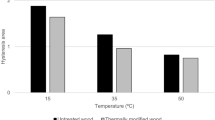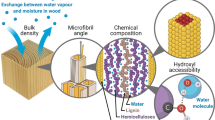Abstract
Changes in the chemical, viscoelastic and hygroscopic properties of wood cell walls in Chinese fir (Cunninghamia lanceolata) during the transition from sapwood to heartwood were studied to provide insights into the formation of heartwood. In situ imaging FTIR measurements indicated that the composition of the main components of cell walls remained almost unaltered, but more extractives were deposited in the wood cell walls during the sapwood–heartwood transition. Compared to the sapwood and transition wood, the heartwood had a higher softening temperature and greater activation energy, suggesting that the mobility restrictions of cell wall biopolymers were due to extractives obstructing the accessing of the plasticizer (ethylene glycol). The moisture sorption was the same from the sapwood to heartwood at a low relative humidity (RH), while the heartwood adsorbed less water at a high RH, probably caused by the extractives deposited in the matrix and mesopores of heartwood cell walls.






Similar content being viewed by others

References
Hillis WE (1985) Occurrence of extractives in wood tissue. In: Higuchi T (ed) Biosynthesis and biodegradation of wood components. Academic Press, Orlando, pp 209–228
Huang Z, Tsai C-J, Harding SA, Meilan R, Woeste K (2010) A cross-species transcriptional profile analysis of heartwood formation in black walnut. Plant Mol Biol Rep 28:222–230
Dehon L, Macheix JJ, Durand M (2002) Involvement of peroxidases in the formation of the brown coloration of heartwood in Juglans nigra. J Exp Bot 53:303–311
Kuroda K, Yamashita K, Fujiwara T (2009) Cellular level observation of water loss and the refilling of tracheids in the xylem of Cryptomeria japonica during heartwood formation. Trees 23:1163–1172
Sorz J, Hietz P (2008) Is oxygen involved in beech (Fagus sylvatica) red heartwood formation? Trees 22:175–185
Burtin P, Jay-Allemand C, Charpentier J-P, Janin G (1998) Natural wood colouring process in Juglans sp. (J-nigra, J-regia and hybrid J-nigra 23 x J-regia) depends on native phenolic compounds accumulated in the transition zone between sapwood and heartwood. Trees 12:258–264
Climent J, Chambel MR, Gil L, Pardos JA (2003) Vertical heartwood variation patterns and prediction of heartwood volume in Pinus canariensis Sm. For Ecol Manage 174:203–211
Song K, Liu B, Jiang X, Yin Y (2011) Cellular changes of tracheids and ray parechyma cells from cambium to heartwood in Cunninghamia lanceolata. J Trop Forest Sci 23:478–487
Taylor AM, Gartner BL, Morrell JJ (2002) Heartwood formation and natural durability-a review. Wood Fiber Sci 34:587–611
Fratzl P, Burgert I, Keckes J (2004) Mechanical model for the deformation of the wood cell wall. Zeitschrift Fur Metallkunde 95:579–584
Page DH (1976) A note on the cell-wall structure of softwood tracheids. Wood Fiber Sci 7:246–248
Salmén L, Olsson A-M (1998) Interation between hemicelluloses, lignin and cellulose: structure-property relationships. J Pulp Pap Sci 24:99–103
Brandt B, Zollfrank C, Franke O, Fromm J, Goken M, Durst K (2010) Micromechanics and ultrastructure of pyrolysed softwood cell walls. Acta Biomater 6:4345–4351
Salmén L, Burgert I (2009) Cell wall features with regard to mechanical performance. A review COST Action E35 2004–2008: wood machining - micromechanics and fracture. Holzforschung 63:121–129
Yin Y, Berglund L, Salmén L (2011) Effect of steam treatment on the properties of wood cell walls. Biomacromolecules 12:194–202
Donaldson L (2008) Mirofibril angle: measurement, variation and relationships-a review. IAWA J 29:345–386
Mauseth JD (2008) Plant anatomy. The Backburn Press, Caldwell
Bertaud F, Holmbom B (2004) Chemical composition of earlywood and latewood in Norway spruce heartwood, sapwood and transition zone wood. Wood Sci Technol 38:245–256
Bergström B (2003) Chemical and structural changes during heartwood formation in Pinus sylvestris. Forestry 76:45–53
Andersson S, Serimaa R, Torkkeli M, Paakkari T, Saranpaa P, Pesonen E (2000) Microfibril angle of Norway spruce [Picea abies (L.) Karst.] compression wood: comparison of measuring techniques. J Wood Sci 46:343–349
Bag R, Beaugrand J, Dole P, Kurek B (2011) Viscoelastic properties of woody hemp core. Holzforschung 65:239–247
Laborie M-P, Salmén L, Frazier CE (2004) Cooperativity analysis of the in situ lignin glass transition. Holzforschung 58:129–133
Salmén L (1984) Viscoelastic properties of in situ lignin under water-saturated conditions. J Mater Sci 19:3090–3096
Stevanic JS, Bergström EM, Gatenholm P, Berglund L, Salmén L (2012) Arabinoxylan/nanofibrillated cellulose composite films. J Mater Sci 47:6724–6732
Wetton RE (1986) Dynamic mechanical thermal analysis of polymers and related systems. In: Dawkins JV (ed) Development in polymer characterization. Elsevier, Barking, pp 179–221
Hagen R, Salmén L, Lavebratt H, Stenberg B (1994) Comparison of dynamic mechanical measurements and Tg determinations with two different instruments. Polym Test 13:113–128
Olsson A-M, Salmén L (1992) Viscoelasticity of in situ lignin as affected by structure, softwood vs. hardwood. ACS Symp Ser 489:133–143
Uhmeier A, Salmén L (1996) Influence of strain rate and temperature on the radial compression behavior of wet spruce. J Eng Mater-T Asme 118:289–294
Yin Y, Bian M, Song K, Xiao F, Jiang X (2011) Influence of microfibril angle on within-tree variation in the mechanical properties of Chinese Fir (Cunninghamia lanceolata). IAWA J 32:431–442
Yin Y, Song K, Liu B, Jiang X (2011) Variation of microfibril angle in Plantation trees of Cunninghamia lanceolata determined by pit apertures and X-ray diffraction. IAWA J 32:77–87
Bao F, Jiang Z (1998) Wood properties of main tree species from plantation in China. China Forestry Publishing House, Beijing
Sahlberg U, Salmén L, Oscarsson A (1997) The fibrillar orientation in the S2-layer of wood fibres as determined by x-ray diffraction analysis. Wood Sci Technol 31:77–86
Åkerholm M, Salmén L (2001) Interactions between wood polymers studied by dynamic FT-IR spectroscopy. Polymer 42:963–969
Stevanic JS, Salmén L (2009) Orientation of the wood polymers in the cell wall of spruce wood fibres. Holzforschung 63:497–503
Åkerholm M, Salmén L (2003) The oriented structure of lignin and its viscoelastic properties studied by static and dynamic FT-IR spectroscopy. Holzforschung 57:459–465
Collier WE, Schultz TP, Kalasinsky VF (1992) Infrared study of lignin: reexamination of aryl-alkyl ether C-O stretching peak assignments. Holzforschung 46:523–528
Faix O (1991) Classification of lignins from different botanical origins by FT-IR spectroscopy. Holzforschung 45:21–27
Qin T, Huang L, Zhou Q (2004) The chemical groups and bonds characterization of juvenile wood and mature wood lignins of Chinese Fir. Sci Silvae Sin 40:137–141
Qin T (2001) Study on FTIR, 1H and 13C NMR characterization of Poplar I-214 heartwood and sapwood lignins. For Res 14:375–382
Hillis WE (1971) Distribution, properties and formation of some wood extractives. Wood Sci Technol 5:272–289
Kampe A, Magel E (2013) New insights into heartwood and heartwood formation. In: Fromm J (ed) Cellular aspects of wood formation. Springer, Berlin Heidelberg, pp 71–95
Lu X, Wang D, Zhou M (1987) Influence of the extractives of Chinese fir wood upon their natural resistance to fungus and termite damages. Sci Silvae Sin 23:456–462
Kleist G, Bauch J (2001) Cellular UV microspectrophotometric investigation of Sapelli heartwood (Entandrophragma cylindricum Sprague) from natural provenances in Africa. Holzforschung 55:117–122
Wang J, Li J, Li S (2011) Components of Cunninghamin lanceolata heartwood extracts. Mater Sci Forum 685:188–194
Adamopoulos S, Koch G (2011) Wood structure and topochemistry of Juniperus excelsa. IAWA J 32:67–76
Wennerblom M, Olsson A-M (1996) Softening properties of earlywood and latewood of spruce. Nord Pulp Paper Res J 11:279–280
Watanabe Y, Kojima Y, Ona T et al (2004) Histochemical study on heterogeneity of lignin in Eucalyptus species II. The distribution of lignins and polyphenols in the walls of various cell types. IAWA J 25:283–295
Matsunaga M, Obataya E, Minato K, Nakatsubo F (2000) Working mechanism of adsorbed water on the vibrational properties of wood impregnated with extractives of pernambuco (Guilandina echinata Spreng.). J Wood Sci 46:122–129
Rautkari L, Hill CAS, Curling S, Jalaludin Z, Ormondroyd G (2013) What is the role of the accessibility of wood hydroxyl groups in controlling moisture content? Journal of Mater Sci 48:6352–6356
Sarkar P, Bosneaga E, Auer M (2009) Plant cell walls throughout evolution: towards a molecular understanding of their design principles. J Exp Bot 60:3615–3635
Choong ET, Achmadi SS (1991) Effect of extractives on moisture sorption and shrinkage in tropical woods. Wood Fiber Sci 23:185–196
Nzokou P, Kamdem DP (2004) Influence of wood extractives on moisture sorption and wettability of red oak (Quercus rubra), black cherry (Prunus serotina), and red pine (Pinus resinosa). Wood Fiber Sci 36:483–492
Wangaard FF, Granados LA (1967) The effect of extractives on water-vapor sorption by wood. Wood Sci Technol 1:253–277
Kuo M-L, Arganbright DG (1980) Cellular distribution of extractives in Redwood and Incense Cedar. Part II. Microscopic observation of the location of cell wall and cell cavity extractives. Holzforschung 34:41–47
Tarkow H, Krueger J (1961) Distribution of hot-water soluble material in cell walls and cavities of redwood. Forest Prod J 11:228–229
Schuetz M, Smith R, Ellis B (2013) Xylem tissue specification, patterning, and differentiation mechanisms. J Exp Bot 64:11–31
Acknowledgements
This study was sponsored by the Chinese State Forestry Administration Project (201104058) and the Chinese National Natural Science Foundation (No. 30972303). Gratitude goes to the following: Mingkun Xu and Lin Liu from the Chinese Research Institute of Wood Industry for the preparation of the samples, Anne-Mari Olsson of Innventia AB for her technical help when making the Dynamic Mechanical Analysis and dynamic vapour sorption, Dr. Jasna S. Stevanic of Innventia AB, Professor Tefu Qin and Dr. Yanming Han of Chinese Research Institute of Wood Industry for their valuable advice on imaging FTIR spectroscopy. Acknowledgement must also go to the support given to Lennart Salmén from the Wallenberg Wood Science Center (WWSC).
Author information
Authors and Affiliations
Corresponding authors
Rights and permissions
About this article
Cite this article
Song, K., Yin, Y., Salmén, L. et al. Changes in the properties of wood cell walls during the transformation from sapwood to heartwood. J Mater Sci 49, 1734–1742 (2014). https://doi.org/10.1007/s10853-013-7860-1
Received:
Accepted:
Published:
Issue Date:
DOI: https://doi.org/10.1007/s10853-013-7860-1



